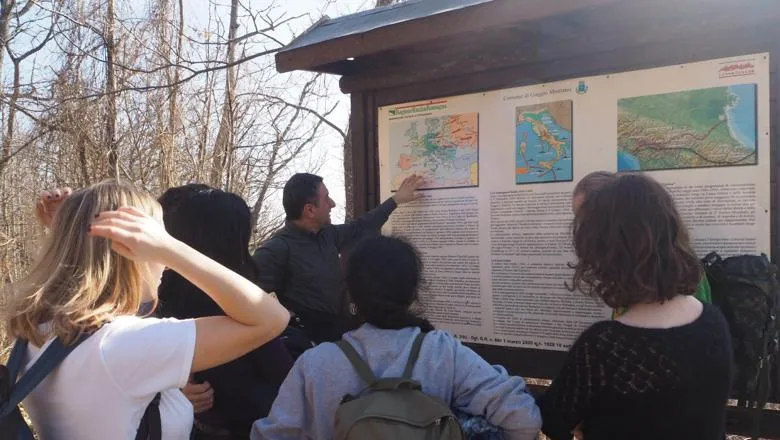17 July 2019
On the trail of the smoking snake
Students follow the footsteps of the WW2 Brazilian Expeditionary Force in Italy

Brazil was the only Latin American country to send troops to Europe to fight alongside the Allies against the Germans. 25,000 soldiers were deployed in Italy in September 1944 and fought in the Apennines until the end of the war in May 1945. 400 of those soldiers lost their lives. Students from the War Studies department recently visited Italy to retrace their steps, accompanied by Dr Vinicius de Carvalho, Senior Lecturer in Brazilian Studies.
“Careli was a young boy when he met the Brazilian soldiers who passed by his family’s house, which sat in between the Axis and Allied fronts. He remembered his encounters with the Brazilian soldiers with great enthusiasm but also sadness. He took us to the graves where the bodies of two Brazilian soldiers were found on New Year’s Day of 1944, marked by a flag drawn on the rock in chalk by Careli so as to never forget them,” recounted Hannah Brown, one of the students on the field trip.
The Brazilians in Italy left their mark in the regions where the troops were stationed and fought between Emilia Romagna and Tuscany. Their presence there is still celebrated and remembered. Many survivors describe the humanitarian approach of the Brazilian troops in relation to the civilian victims of the conflict and many cultural exchanges occurred.
“For a long time it was believed that Brazil would never enter the European battlefield. The popular saying at that time was “it’s more likely for a snake to smoke a pipe than for the Brazilian expeditionary force to go to the front and fight”. Nevertheless, the snake did smoke after all. When we arrived in Italy, I was eagerly looking for the symbol of the snake with a pipe, used as a shoulder patch for army uniforms. I was not disappointed,” said Aleksandra Kusnierkiewicz.
Claudia Lombardo Díez added: “On the third day of the trip, we drove deeper into the astonishing Italian mountains to pay a visit to Iolanda, an incredible lady who lived with the Brazilian soldiers for some time during the war. Suddenly, the abstract idea of the Second World War took the form of a tangible story about a food can and a chimney, children being thrown up and caught back by playful soldiers, and the death of a close family member.”
The immersion allowed the students to gain an idea of what it was like for young Brazilian soldiers from the tropics to arrive in Italy and stay throughout the winter, in a mountainous region, and have to confront a well-trained and experienced enemy.
“One of the most memorable experiences of our trip was the steep hike along a mountain slope that had formed part of the Gothic Line – the German army’s last major line of defence in Italy. Riddled with dugouts, trenches and grottos converted into bunkers, the slope is testament to how WWII created and shaped its own battlefields as soldiers sought to exploit the advantages of the terrain. Thanks to our guide, Mario, and his vivid account of the Brazilian troops’ grindingly slow advance against the Germans, it was easy to envision the defensive positions as they must have been and the deadly obstacle they presented,” said Dorian T. Boyd.
Students got an idea of what it was like for the Brazilian soldiers to experience the culture shock of having to fight in an international force without the necessary language skills and interact with a population affected by a long-term conflict. There was also a focus on the ways that Italy cultivates the memories of the Brazilian presence during the war today.
"The ceremony at Monte Castello was poignant as it regrouped so many different people including Italian officials, Brazilian officials, people who had a particular link with this historical moment, as well as civilians, and us, foreign students celebrating the achievement of the Brazilian army. It is important that generations that have no direct memory of this battle, still commemorate and continue the celebration of this historical liberation that was so important for the Italian people, as well as for the Allies," concluded Olivier Clement.
Reflections by Aleksandra Kusnierkiewicz, Claudia Lombardo Díez, Dorian T. Boyd, Hannah Brown, Jesie K. Randhawa, Olivier Clement & Roger Padierna Sansores. Supervisor: Dr Vinicius de Carvalho | Local guide: Mario Pereira
See more photos of the trip on the War Studies Instagram page.
